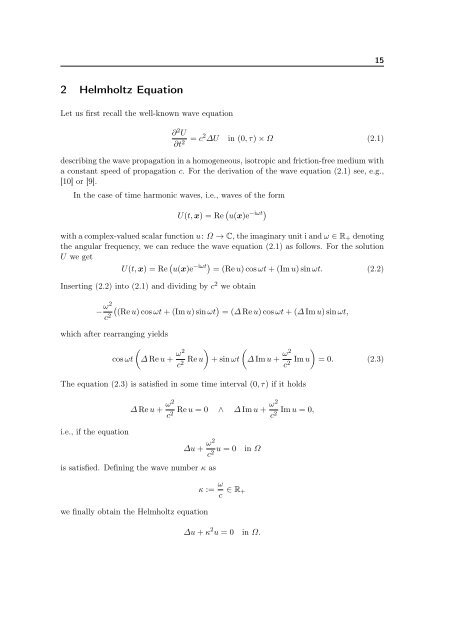The Boundary Element Method for the Helmholtz Equation ... - FEI VÅ B
The Boundary Element Method for the Helmholtz Equation ... - FEI VÅ B The Boundary Element Method for the Helmholtz Equation ... - FEI VÅ B
152 Helmholtz EquationLet us first recall the well-known wave equation∂ 2 U∂t 2 = c2 ∆U in (0, τ) × Ω (2.1)describing the wave propagation in a homogeneous, isotropic and friction-free medium witha constant speed of propagation c. For the derivation of the wave equation (2.1) see, e.g.,[10] or [9].In the case of time harmonic waves, i.e., waves of the formU(t, x) = Re u(x)e −iωtwith a complex-valued scalar function u: Ω → C, the imaginary unit i and ω ∈ R + denotingthe angular frequency, we can reduce the wave equation (2.1) as follows. For the solutionU we getU(t, x) = Re u(x)e −iωt = (Re u) cos ωt + (Im u) sin ωt. (2.2)Inserting (2.2) into (2.1) and dividing by c 2 we obtain− ω2c 2 (Re u) cos ωt + (Im u) sin ωt= (∆ Re u) cos ωt + (∆ Im u) sin ωt,which after rearranging yieldscos ωt∆ Re u + ω2c 2 Re u + sin ωt∆ Im u + ω2c 2 Im u = 0. (2.3)The equation (2.3) is satisfied in some time interval (0, τ) if it holdsi.e., if the equation∆ Re u + ω2ω2Re u = 0 ∧ ∆ Im u + Im u = 0,c2 c2 ∆u + ω2c 2 u = 0in Ωis satisfied. Defining the wave number κ asκ := ω c ∈ R +we finally obtain the Helmholtz equation∆u + κ 2 u = 0 in Ω.
- Page 3: I hereby declare that this thesis i
- Page 7: AbstractIn this work we study the a
- Page 13 and 14: 1IntroductionThe boundary element m
- Page 15 and 16: 31 Function SpacesIn this section w
- Page 17 and 18: 5∂Ωy i 2ΩU + iU − iΓ iy i 1F
- Page 19 and 20: 7For a special choice of p = 2 we g
- Page 21 and 22: 9Note that the trace operator is no
- Page 23: 11Definition 1.8 (Weak Solution). C
- Page 29: 17the boundary value problem (see,
- Page 33 and 34: 21Because ṽ κ ∈ L 1 loc (R3 )
- Page 35 and 36: 23In particular, if u satisfies the
- Page 37 and 38: 25Ωn to ∂Ω ε0n to ∂Ω∂Ω
- Page 39: 27andI 2 :=∂B ε(0) ∂uv κ (x,
- Page 42 and 43: 30 3 Boundary Integral EquationsInt
- Page 44 and 45: 32 3 Boundary Integral EquationsBec
- Page 46 and 47: 34 3 Boundary Integral EquationsAga
- Page 48 and 49: 36 3 Boundary Integral Equationswit
- Page 50 and 51: 38 3 Boundary Integral Equationswit
- Page 52 and 53: 40 3 Boundary Integral EquationsAcc
- Page 54 and 55: 42 3 Boundary Integral EquationsSim
- Page 56 and 57: 44 3 Boundary Integral Equationsand
- Page 58 and 59: 46 3 Boundary Integral EquationsSim
- Page 61 and 62: 494 Discretization and Numerical Re
- Page 63 and 64: 51with x k∗denoting the midpoint
- Page 65 and 66: 53k \ τ k x k 1x k 2x k 3local ind
- Page 67 and 68: 55which corresponds to a vector g D
- Page 69 and 70: 57with∂v κ(x, y) = 1 e iκ∥x
- Page 71 and 72: 59represented by vectors t ∈ C N
- Page 73 and 74: 614.3.4 Exterior Dirichlet Boundary
- Page 75 and 76: 63[8] (see also [16]) can be used.
152 <strong>Helmholtz</strong> <strong>Equation</strong>Let us first recall <strong>the</strong> well-known wave equation∂ 2 U∂t 2 = c2 ∆U in (0, τ) × Ω (2.1)describing <strong>the</strong> wave propagation in a homogeneous, isotropic and friction-free medium witha constant speed of propagation c. For <strong>the</strong> derivation of <strong>the</strong> wave equation (2.1) see, e.g.,[10] or [9].In <strong>the</strong> case of time harmonic waves, i.e., waves of <strong>the</strong> <strong>for</strong>mU(t, x) = Re u(x)e −iωtwith a complex-valued scalar function u: Ω → C, <strong>the</strong> imaginary unit i and ω ∈ R + denoting<strong>the</strong> angular frequency, we can reduce <strong>the</strong> wave equation (2.1) as follows. For <strong>the</strong> solutionU we getU(t, x) = Re u(x)e −iωt = (Re u) cos ωt + (Im u) sin ωt. (2.2)Inserting (2.2) into (2.1) and dividing by c 2 we obtain− ω2c 2 (Re u) cos ωt + (Im u) sin ωt= (∆ Re u) cos ωt + (∆ Im u) sin ωt,which after rearranging yieldscos ωt∆ Re u + ω2c 2 Re u + sin ωt∆ Im u + ω2c 2 Im u = 0. (2.3)<strong>The</strong> equation (2.3) is satisfied in some time interval (0, τ) if it holdsi.e., if <strong>the</strong> equation∆ Re u + ω2ω2Re u = 0 ∧ ∆ Im u + Im u = 0,c2 c2 ∆u + ω2c 2 u = 0in Ωis satisfied. Defining <strong>the</strong> wave number κ asκ := ω c ∈ R +we finally obtain <strong>the</strong> <strong>Helmholtz</strong> equation∆u + κ 2 u = 0 in Ω.




